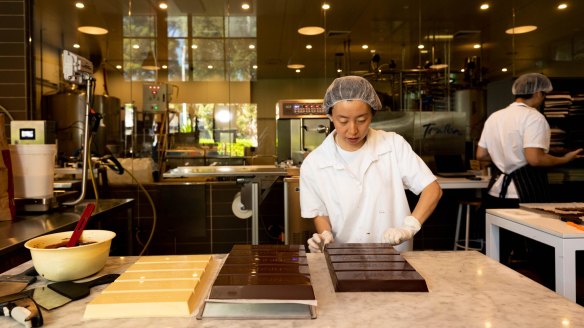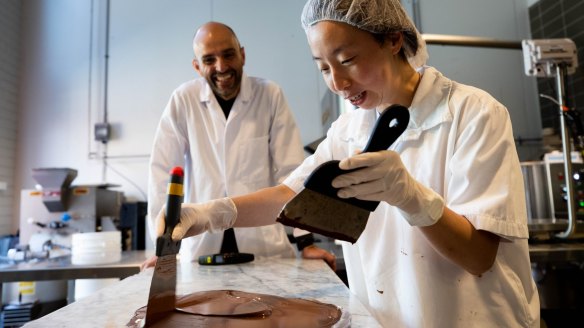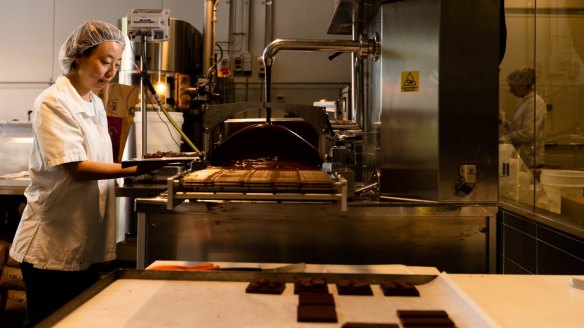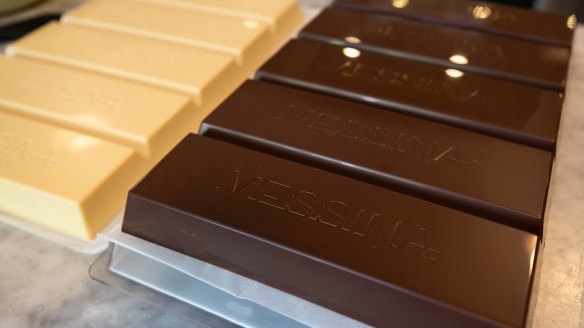Gelato Messina is making couverture chocolate for chefs and home cooks

Couverture chocolate is silky, creamy and delicious, and used by the world's best chefs from Melbourne to Madrid. It's also one of the last food categories Australian producers are yet to conquer.
"Chocolate making is what I'd call an extreme sport," says Sally Gosper, general manager of artisan food purveyor Two Providores.
"There is very little room for error. It requires many components to get it right. You have to have the capacity to invest in some very expensive equipment and have a commitment to excellence.

"More importantly than that, however, chocolate making requires serious academic rigour combined with an excellent palate."
Gosper was more than excited to meet Donato Toce last year, the co-owner and head of development at Gelato Messina, which now has 19 dessert stores nationwide.
After months of trial and error, Toce has cracked a recipe for making couverture chocolate on a commercial scale for Australian chefs and home cooks.

Couverture contains a higher percentage of top quality cocoa butter than standard chocolate, making it ideal for coating and dipping in professional kitchens, and moulding into detailed creations.
Most couverture used in Australia is made in Belgium, Switzerland or Asia. Messina's first batches for the wholesale market will come off the line at its Sydney headquarters this week.
"Messina started making chocolate for our gelato in 2017," says Toce. "We were importing 40-foot containers of chocolate from Europe when we thought 'most of this is just sugar and milk solids'."

The former Melbourne chef turned food innovator decided to make better chocolate at a better price. He bought an industrial mill that uses platinum balls to smash roasted ground cocoa beans into super smooth chocolate. But, that's just for the standard stuff.
For his special range of couverture, Toce uses cocoa sourced from Peruvian Criollo cocoa bean, considered the Rolls Royce of the chocolate world and making up only one per cent of global cacao production.
Messina has also created an all-Australian couverture chocolate, limited to a batch of just 100 kilograms, and made from cocoa grown in the Daintree Rainforest.
The local batch has been sold to chefs such as Matt Moran to be used at Aria, Ross Lusted from Woodcut at Crown Sydney, and Lennox Hastie of Firedoor, Surry Hills.
"We have been working with Donato and his team on the chocolate for some time," says Hastie.
"They have let us into the development process, and we helped shape the product in ways that suit us. This couverture chocolate is probably the best product available in Australia. It's so distinct."
Home cooks will be able to order the chocolate from the Two Providores online store by the end of the month.
"Having worked for some of the world's greatest couvertures, I had always hoped we would be able to produce world class chocolate on a commercial scale in Australia," says Gosper. "Finally, here we are."
Beyond the chocolate and left-field gelato flavours, Messina also supplies restaurants with raw materials such as nuts and dairy from its own farms.
In 2015, to make sure the company had enough high-quality milk for the 1.25 million litres of gelato it makes each year, Toce and his partners bought a dairy farm near Numurkah in northern Victoria.
Messina turned the operation on its head to ensure the quality of the milk. Heavy-milking Friesian cows were replaced with high butter-fat producing Jerseys. The herd's diet was changed from grain to pasture. Milking was reduced from twice daily to once a day and calves were left with their mothers to reduce stress.
"We wanted the cows to produce the best milk, so we gave them the best life," says Toce.
Until recently, the company was also using 10 tonnes of hazelnuts a year, imported from Italy. "We use the same variety as Ferrero Rocher, says Toce. "Ferrero are so big they dictate the price of hazelnuts in Europe. If there is a seasonal shortage, the price can double."
So in 2014 Toce and his team purchased a 14 hectare hazelnut farm near Seymour, 90 kilometres north of Melbourne. The only problem was the trees were the wrong variety and the skins wouldn't peel.
Messina replanted the farm with a special Italian variety and in autumn those trees will produce their first harvest. Until then, Toce is using hazelnuts from a neighbouring farm.
"Every decision we make, it's about quality," he says.
with Callan Boys
Restaurant reviews, news and the hottest openings served to your inbox.
Sign up- More:
- Restaurant news
